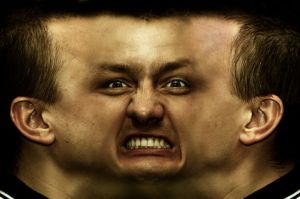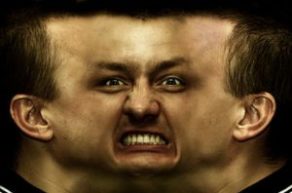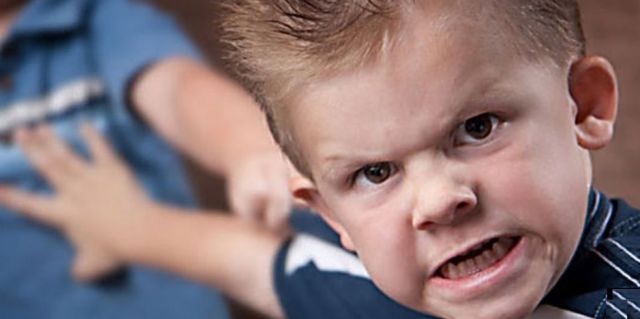They call a pronounced form of disorders that have a mental type. The companions of psychosis are delusional states, abrupt mood changes, hallucinations, states of arousal, uncontrollable or depressive behavior, a violation of the thought process and a complete lack of the ability to critically assess one's condition.
Childhood psychosis can be symptomatic or functional. The first type is associated with psychological causes, while the second is associated with physical damage, such as illness or injury of various types. In terms of age, childhood psychosis usually manifests itself after three years. In some cases, this may be motivated by complex family contexts. In these situations, children tend to be victims of the family situation and the problems of their parents. Unconsciously, your mind can distort the atmosphere of tension as a defensive weapon.
In terms of symptoms, most research on childhood psychosis distinguishes between two types. On the one hand, signs such as hallucinations, behavioral and language problems, and on the other, symptoms such as depression and apathy are aimed at attracting the attention of parents and in some way exercising control over them. Unconscious mechanisms that often arise as a result of trauma, situations and contexts, especially stressful or serious family problems. Affective childhood psychosis serves the child to convey a message, to show their discomfort, and ultimately to warn adults that something is not working as it should, perhaps even in them.
Causes of psychosis
The emergence of psychosis is promoted by causes that have a variety of characteristics. The causes of psychosis are primarily classified according to internal and external factors. The presence of external factors leads to the development of an exogenous type of psychosis. External sources of psychosis are: various infections (flu, typhus, and so on), alcohol and drug addiction, poisons of industrial origin, any stress or trauma of a psychological nature. The leader of external causes is alcohol, its abuse results in alcoholic psychosis.
Other forms of psychosis are the so-called symbiotic syndrome, caused by the separation of the mother causing a severe episode of anxiety and panic, and is also characterized by alternating mood swings between hyperactivity and depression. The symbiotic syndrome can be associated with, among other reasons, a cold and distant maternal attitude, which can make the child feel that he is not adequately protected.
Psychosis is psychological disorder in which the mental state of a person changes. The psychotic person lives in two worlds at the same time, in the real world and in his imagination, but he cannot distinguish between them, and often they merge. The main symptom of psychosis is delirium. Individuals in a state of psychosis cannot distinguish reality from fantasy, usually do not know how to position themselves in time and space, and have many splits. The psychotic may claim that the downstairs neighbor wants to kill him, even though he knows no one lives in the apartment below.
Internal factors that influence the development of psychosis lead to the manifestation of an endogenous type of psychosis. Sources of this type are predominantly impaired functions nervous system and imbalance endocrine system. Endogenous psychosis is closely related to age-related changes occurring in the body, the so-called senile psychosis. It develops as a result of hypertensive processes, with lesions of the brain vessels by atherosclerosis and with.
Usually a psychotic person is agitated, aggressive and impulsive, but the main symptoms of psychosis are. Delusions, hallucinations such as hearing voices, sudden mood changes that become very happy in an instant and depressive in the near future, Speaking very quickly or very slowly, Difficulty expressing, Speaking nonsense and phrases that are difficult to understand, Mania and uncontrollable fears, Confusion difficulties in relation to others, agitation, insomnia, suicidal behavior, aggression and self-harm. Psychosis usually appears in adolescents or adolescents and may be temporary or associated with other mental illnesses such as bipolar disorder, Alzheimer's disease, epilepsy, schizophrenia, depression, and prevalence among drug users.
The difference between endogenous psychosis is the duration and the possibility of repetition. This psychosis causes a complex condition in which it is problematic to establish real reasons its occurrence. Sometimes the primary source may lie in external factors, and then it is supplemented internal problems. Senile psychoses require allocation in a separate group. As a rule, they appear no earlier than 60 years of age with endomorphic disorders and a state of clouding of consciousness, but without the development of complete dementia.
Treatment for psychosis must be directed by a psychiatrist and consists of antipsychotics and mood stabilizers such as risperidone, haloperidol, lorazepam, or carbamazepine. Often, in addition to medications, it is necessary to mental asylum where treatment with electroconvulsive devices can be carried out. Hospitalization can take 1 to 2 months until the person gets better and can be fired due to the fact that he/she can no longer expose his/her life and the life of others but keep the person in check, the psychiatrist can still keep the medication which can be taken for many years.
Psychosis can occur in a reactive and acute form. The reactive form includes psychoses that occur in the form of temporary reversible disorders that have mental character and arising from any type of trauma of the mental type. The acute form of psychosis occurs suddenly and develops rapidly. Any unexpected news, for example, about the death of a close relative or the loss of something, can serve as an impetus for development. Observations show that psychosis in more women are more susceptible than men and it does not depend on race and financial situation.
In addition, weekly sessions with a psychologist or psychiatrist can be helpful in reorganizing ideas and improving. In the case of postpartum psychosis, the doctor may also prescribe medication, and when the psychosis puts the child's life at risk, the mother may be removed from the child, and even hospitalization is necessary. Usually, after treatment, the symptoms disappear and the woman returns to normal, but there is a risk of a new psychotic picture appearing in another postpartum period.
Psychosis does not have a single cause, but several related factors can lead to its onset. Some factors that contribute to the development of psychosis. To arrive at a diagnosis of psychosis, a psychiatrist must observe someone personally trying to identify the symptoms presented, and may also request blood tests, X-rays, CT scans, and MRIs to try to determine if there are any changes that may be causing the psychosis or introducing confusing other diseases.
Symptoms of psychosis
The rich human psyche enables psychosis to manifest without limit. The main symptoms of the disease include hallucinations, the occurrence of delusional ideas, motor disorders and mood disorders. Hallucinations are auditory, olfactory, visual, tactile and gustatory. Their manifestations can be in a simple (call, call) and complex (speech) form. The most common hallucinations are auditory in the form of voices sounding in the head of the patient or coming from outside.
Psychosis is a term used to identify mental disorders in which a person loses contact with reality. The mental functioning of a psychotic person is compromised on several levels, causing signs and symptoms that include hallucinations, delusions, mental confusion, memory loss, bizarre behavior, and others.
The term "psychotic" can also be used to refer to disturbances in personal and social relationships or isolated behavior at any given time. Loss of contact with reality means that a person misjudges their perceptions and thoughts, which leads them to draw incorrect conclusions from the real world, even if the evidence proves otherwise.
Ideas of delusional content constitute judgments and conclusions that do not correspond to reality. They completely capture the consciousness of the patient, while it is impossible to dissuade him or explain anything to him. The most common are delusional ideas about persecution (surveillance, intrigue), about negative impact (special services, aliens, damage, and so on), about causing damage (surviving from an apartment, stealing things, poisoned food), about a terrible deadly disease. Sometimes there is delusions of grandeur, jealousy, love, and so on.
The most obvious sign of psychosis is the manifestation of delusions or hallucinations without realizing the pathological origin of these symptoms. To understand the difference between an illusion and a hallucination, the following example can be used. A man enters a place, sees a police officer and, for no reason, wants to run away because he believes that the police there are arresting him. In this case, the police are real but not there to arrest the person. It was she who imagined this situation and believed that it was true.
The hallucination would be seeing a policeman or hearing a police siren without them, as that is what defines a hallucination: seeing or hearing something that doesn't exist. There are several types of psychotic disorders such as schizophrenia, delusional disorder, substance-induced psychotic disorder, brief psychotic disorder, and others. Even people with non-psychotic psychiatric disorders can experience psychotic symptoms, such as with severe depression.
Disorders of motor functions are manifested by lethargy (stupor), when the patient maintains one position for a long time, is inactive, his gaze is directed to one point, he does not answer the questions posed and stops eating. The other side of motor disorders is the patient's being in a state of excitement, when he is constantly on the move, speaks non-stop, sometimes makes faces, mimics the interlocutor, is possibly aggressive, can commit an unmotivated act.
However, it is important to differentiate the syndrome from a psychotic disorder. The psychotic syndrome represents the main symptoms of psychosis, but it is not the disease itself. There are several disorders or mental illness, which cover features of a psychotic disorder without necessarily being psychotic.
Among the signs and symptoms that characterize the psychotic syndrome. Sudden onset of hallucinations, especially when accompanied by delusional ideas and inconsistency in the organization of ideas, as well as disorientation in space and time. Excessive distrust, isolation, lack of interest in social activity, hostility and aggression, severe sadness, insomnia, thoughts or attempts at suicide, inattention to personal hygiene, euphoria, insomnia, grand plans or ideas, psychomotor agitation or agitation, exaggerated eloquence, alien to the outside world , with a significant predominance inner peace, strange or bizarre behavior, difficulty expressing emotions and feelings. The most common psychotic disorders, according to age group, are.
Disorders in the mood of the patient are expressed by states of a depressive or manic nature. can be seen by a lowered mood, manifested in the form of longing, depression, mental retardation, a pessimistic assessment of the past and future, suicidal thoughts. The manic state is assessed by an unreasonably elevated mood, by the acceleration of thinking and speed of movement, by planning unrealistic (fantastic) prospects, by lack of sleep, by abusing something.
Treatment for psychosis may include medication, psychotherapy, family counseling, exercise, and hospitalization. A psychiatrist is a specialist responsible for the diagnosis and treatment of syndromes and psychotic disorders. Both in clinical practice and in social aspects associated with treatment. Why are we interested in these unusual people who are psychotic?
It's one thing, of course, not to chew on a rope when it comes to psychosis. This is already a whole, in addition to being an extra point in the list of our virtues. The truth is that we find several professionals among those who are trained, willing to visit psychotic patients. It is very difficult to live with the volatility that madness causes, so few people are willing to do so, and even fewer are capable of constructive friendliness. In this we should be congratulated.
A person in a state of psychosis changes in behavior, emotional manifestations and thinking. Such metamorphoses testify to the loss of the ability to really perceive the world, which is affected by the complete lack of awareness of what is happening and the inability to assess their altered psyche. Patients with altered consciousness, who are in a depressed state, resist treatment and hospitalization.
We are not superheroes, there are other rappers, other types of patients who make violent resistances and put many professionals on the run. Some specific sexual fantasies cannot be carried by anyone. How many of us can't deal with depression. Working with the ghost of death around is also not encouraging, remember to keep track of terminally ill patients. A clinic with physically handicapped people and neurological compromises where a healing fantasy can hardly be established requires great commitment.
Found a mistake in the text? Select it and a few more words, press Ctrl + Enter
Diagnosis of psychosis
When making a diagnosis, the doctor takes as a basis the features of the symptoms and the nature of the dynamics of this disorder. Many of the symptoms of psychosis occur in a mild form long before the onset of the disease and are serious harbingers of the disease. The first signs of psychosis are very difficult to recognize. These include changes in character, when a person shows excessive irritability, nervousness or anxiety, his sleep is disturbed, his appetite disappears, his appearance can be described as strange or unusual.
It takes Zen patience to maintain photographs that never improve, or degenerate photographs when accompanied by aggravation. They want to see something very simple, but it can also be unbearable: childhood, contact with certain aspects of a child is enough for some professionals to retreat.
The point is that, since we do not all agree with any of the claims, it would be wise not to accept the negative judgment of those who choose not to work with psychotics. If we have a sensitivity or a calling, we may be afraid of other things. What we have at hand is indeed an unusual and very difficult task. The only remark that would be made by those who do not want to know about psychotics is the failure of education: if there is anything that revolutionizes our conception of the subject, even the neurotic subject, it is the experience of psychosis.
A sign of incipient psychosis may be a change in performance, which is expressed in a decline in activity, and in a sharp form, reduced resistance to stress, and the inability to maintain attention. Feelings can change: mood swings, the appearance of fears, depression due to trifles. Another sign is a change in habits manifested in isolation, distrust, problems in communication, complete withdrawal into oneself. The onset of psychosis can be indicated by a sudden change in interests and perceptions (colors, sounds).
It is as if we could see the neurosis inside out, said in a crude way, because psychosis is not simple. The psychotic patient is synonymous with discomfort. This is where the narcissism of clinical reputation comes into play. Each therapist's clinic receives transparency in psychotic care.
In the vast majority of cases, the transparency that is presented publicly is facts that make you think that a professional does not have the reins of control over the process. Psychotic work includes parents, relatives, friends, communities, schools, institutions, and so on. Therefore, it is more external, more public, therefore the style is more manifested. More than ever, we will be held accountable for this or that act or intervention. It gives a lot more work, and work comes in, and mostly bugs come in.
Signs of a mental disorder cause anxiety in the patient's relatives, who begin to suspect schizophrenia, although psychosis has other causes. Therefore, it is very important to conduct a timely, thorough examination of the patient in order to avoid serious consequences that manifest themselves as a psychotic state, stroke, and so on. The real cause of psychosis is found out by a qualified psychiatrist using complex high-tech methods.

Treatment of reactive psychosis at the first stage requires the elimination of the cause of the disease where possible. The reaction of affective shock, in the absence of its transition to a different state, does not require the help of a doctor. All other types of psychosis require rapid hospitalization of the patient, since the presence of psychosis does not allow him to control his actions and threatens to cause unconscious harm to himself or others.
For treatment, a clinical justification is necessary - the correct diagnosis, reliable identification of the severity of the disease, psychopathic symptoms, individual characteristics of the patient's personality and his physical health. In drug therapy, psychotropic drugs are used, mainly antipsychotics, sometimes tranquilizers. To them are added medicines of general strengthening action, if necessary - antidepressants.
To date, drugs have been created that can act selectively, only on a certain type of psychosis. In the case of psychosis, which appeared as a result of intoxication, drugs are used that help cleanse the body. In any case, the prescription of drugs takes into account an individual approach, professional specialist. The doctor takes into account the causes of the disease, the age of the patient, other existing diseases and contraindications.
Drug treatment, as a rule, is carried out in parallel with the rehabilitation of a psychological nature. It is necessary to improve the effectiveness of the treatment. The task of the psychiatrist is to find contact with the patient and inspire him with positive thoughts about recovery, about the need to take medication, about his soon return to normal life. The patient is guaranteed complete anonymity of treatment.
The rehabilitation course also includes training programs. They help patients develop a different reaction to the world around them, teach new form life behavior. After the completion of the rehabilitation program, the patient must establish himself in a sense of his equality in society, have a better attitude towards himself and other people who also feel their inferiority due to their psychosis and those who deny their disease.
Physiotherapeutic methods relieve emotional overstrain. Promote better metabolism, increase the ability to work. They are prescribed as an addition to the main treatment and include such procedures as physiotherapy exercises, reflexology with needles, electrosleep, sanatorium treatment. If necessary, electroconvulsive treatment is carried out, which causes convulsive seizures by an artificial method using alternating current. It effectively affects certain areas of the brain.
Timely treatment to a greater extent increases the receipt of a positive result and quickly normalizes the patient's condition.
Acute psychosis is a pronounced violation of mental activity, manifested in an inadequate perception of reality and oneself. With this disease, a person can completely lose control over their own behavior and actions.
In this state, are often observed,. The disease can develop against the background of a somatic illness, psychotrauma, or after strong emotional upheavals.
Psychosis in an acute form is usually not a single phenomenon, but constantly recurring. At what the probability of a recurrence is high. But unlike the chronic form, acute psychosis is temporary. mental disorder may last several days or weeks. The prognosis of therapy is favorable.
People suffering from this disease often withdraw into themselves and do not accept the help and advice of loved ones. Therefore, it is important to diagnose the problem as early as possible so that timely therapy, albeit forced, is prescribed. Indeed, over time, the adequacy of a person becomes lower and lower, against the background of which irreversible processes for the mental state may appear.
Causes and forms of acute psychosis
According to statistics, women are more likely to suffer from acute psychosis. This is probably due to hormonal imbalances.
Depending on the cause that provoked the development of the disease, the following types of acute psychosis are distinguished:

According to clinical manifestations, the following types of deviations are observed:

It is often difficult to diagnose the initial cause of the disease. The impetus may be a combination of several factors.
alcohol form
 Acute develops in those people who abuse alcohol for several years. And it develops in the case when a person abruptly abandons his bad habit. Alcoholic psychosis manifests itself as follows: there is a sharp change in mood, hallucinations and delusions appear, the patient is dangerous to others.
Acute develops in those people who abuse alcohol for several years. And it develops in the case when a person abruptly abandons his bad habit. Alcoholic psychosis manifests itself as follows: there is a sharp change in mood, hallucinations and delusions appear, the patient is dangerous to others.
In this condition, immediate admission to the hospital and bed rest is required. Usually the patient does not understand what is happening and resists.
In the hospital, he will be constantly monitored, and an appropriate course of therapy will be prescribed.
mental breakdown after childbirth
This condition may appear in the first weeks after the birth of the baby. The main cause of mental disorders is illness during childbearing and pain shock during childbirth. How does it manifest itself? The woman becomes very emotional, tearful, sleep problems appear, there is no appetite.
Emotional behavior can be different. Some women are indifferent to their baby, while others begin to take care of all the children in the ward. Some young mothers may be in a state of euphoria, while others, on the contrary, become withdrawn and taciturn.
Acute psychosis should not be confused with postpartum depression. In the second case, delirium and hallucinations are absent. Women in labor with such mental disorders should be referred for treatment, otherwise there may be terrible consequences, up to suicide or the death of the baby.
Psychotic behavior in children can manifest itself in different ways. The most important sign is, that is, the ability to hear and see what is not in reality.
There is also delirium, incomprehensible laughter for no reason and irritation. Psychosis in a child can develop against the background of short-term or long-term states of physical appearance. This is the use of drugs, fever, hormonal disruptions. It is important to cure the underlying disease, then the mental deviation will also pass.
If psychosis is suspected, the necessary diagnostic tests should be carried out. It is required to visit a neuropathologist, a specialist in developmental diseases, an ENT doctor, a speech therapist. If the child has experienced severe stress, long-term psychotherapeutic support will be required.

Risk factors
Different types of mental disorders may occur in different life cycles. In adolescence, there is a high probability of development.
In old age, when age-related changes often occur in the vessels and are disturbed, it is formed.
Young ambitious individuals are more likely to be affected by the manic-depressive type. During this life period, some global change in fate can adversely affect mental health.
As for the sex factor, statistics show that the disease develops in men and women in the same way. But there are types of the disease, which men are more susceptible to. This and also at . And here  manic-depressive syndrome is three times more common in women, since hormonal surges often occur in the weaker sex.
manic-depressive syndrome is three times more common in women, since hormonal surges often occur in the weaker sex.
If we consider the geographical factor, it is noted that mental illnesses affect residents of large cities more. Because in the metropolis there is a high level of stress and a frantic pace of life, so the psyche suffers.
The social factor manifests itself when a person could not realize himself. For example, a girl did not marry and could not give birth, or a man did not achieve his goals. In such cases, the burden of negativity puts pressure on the person, but contributes.
Symptoms of the disease
The disease manifests itself from different sides. It all depends on the characteristics of the organism and the causal factor that led to the failure in the psyche.
Alarming symptoms that may indicate a possible acute psychosis:;
Modern approach to treatment
Treatment of acute psychosis should begin as early as possible. Only a qualified psychotherapist can identify the provocative cause and prescribe high-quality therapy. You can not leave the patient at home on self-treatment.
Modern specialists use the following methods of therapy:
For high-quality treatment, a complex of different measures is needed. Such a complex is individual for each person and only a good doctor can pick it up. Timely therapy will help increase the likelihood of a good prognosis.
It should be remembered that psychosis is a curable disease. The main thing is not to delay the therapy. Only self-discipline, regular use of drugs, psychotherapy and the help of others will help restore mental health and joy of life.



